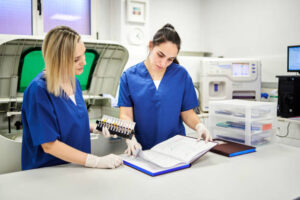In precision-driven industries, the accuracy and reliability of measurements are paramount. One of the most effective ways to ensure this is by developing an uncertainty budget for your calibrations — a detailed account of all potential sources of uncertainty in a measurement, allowing you to quantify and manage them effectively. At THE SCALE PEOPLE/LAB PEOPLE, we advocate for the creation of uncertainty budgets as a best practice in calibration.
Here’s why you should consider developing an uncertainty budget, and how it can benefit your operations:

Increase measurement accuracy, ensure regulatory compliance, and improve quality control by identifying and managing uncertainties.
What Is an Uncertainty Budget?
An uncertainty budget is a comprehensive analysis that identifies and quantifies all possible sources of uncertainty in a measurement process. It includes various factors such as instrument precision, environmental conditions, and operator expertise, all of which contribute to the overall uncertainty of a measurement.
Benefits of Developing an Uncertainty Budget
1. Increased Measurement Confidence
A well-developed uncertainty budget provides a clear understanding of the measurement’s accuracy, increasing confidence in the results. This is particularly important in fields where precise measurements are critical.
2. Regulatory Compliance
Many industries are subject to stringent regulatory standards that require the documentation and reporting of measurement uncertainties. Developing an uncertainty budget helps you comply with standards such as ISO/IEC 17025:2017, ensuring that your calibration processes meet the necessary quality and accuracy requirements.
3. Better Quality Control
Understanding and managing uncertainties lead to better quality control in your processes. It helps in identifying potential issues early and implementing corrective actions, ensuring consistent quality.
4. Risk Management
Understanding the uncertainties in your measurements allows you to assess and mitigate potential risks. This is particularly important in industries where measurement errors can lead to significant financial losses or safety hazards.
5. Process Optimization
By understanding and managing uncertainties, you can optimize your measurement processes. This leads to more efficient operations, reduced waste, and better utilization of resources, ultimately saving time and money.
How to Develop an Uncertainty Budget
-
Identify Uncertainty Sources
-
List all potential sources of uncertainty in your measurement process, including instrument precision, environmental conditions, and operator expertise.
-
-
Quantify Uncertainties
-
Use statistical methods and historical data to quantify the uncertainties associated with each source. This involves calculating standard deviations, confidence intervals, and other relevant metrics.
-
-
Document and Review
-
Document the uncertainty budget in detail, ensuring that all sources and calculations are clearly explained. Regularly review and update the budget to account for changes in the measurement process or equipment.
-
Conclusion
Developing an uncertainty budget is a critical step in ensuring the accuracy and reliability of your calibrations. It provides a comprehensive view of all potential errors, enhances regulatory compliance, and improves process optimization. At THE SCALE PEOPLE/LAB PEOPLE, we offer expert guidance and comprehensive calibration services to help you develop and manage your uncertainties, ensuring the highest standards of accuracy and reliability.
Let us assist you in developing an uncertainty budget that enhances the precision and reliability of your measurements. Contact us today at LABPEOPLE.COM to learn more about our ISO/IEC 17025:2017 accredited services ensure that your measurements are precise and reliable to help you achieve the highest standards in your operations.
This entry was posted on Tuesday, August 20th, 2024 at 9:04 am. You can follow any responses to this entry through the RSS 2.0 feed. You can leave a response, or trackback from your own site.
